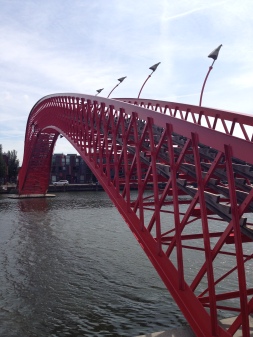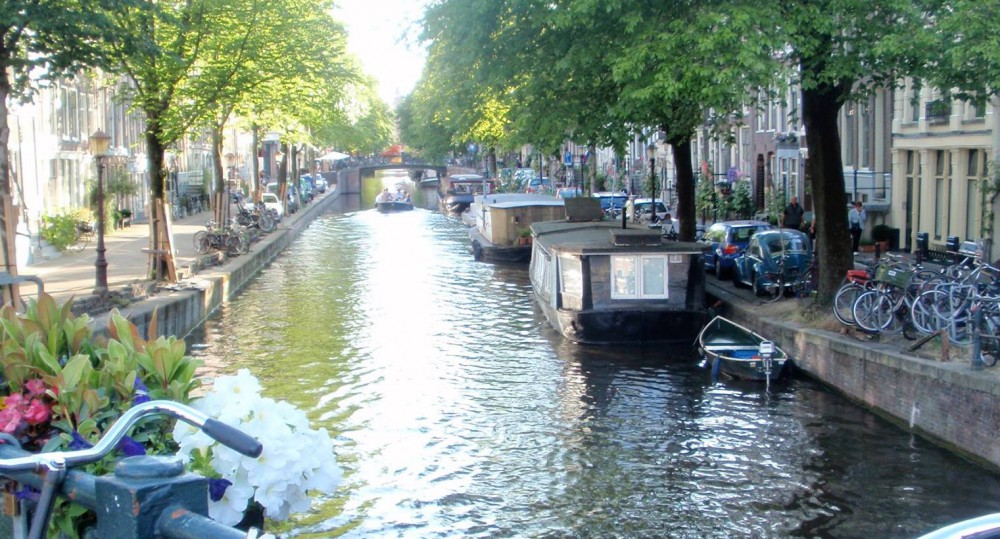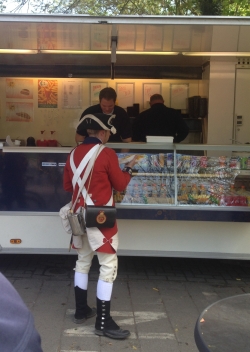In spite of what you might have gathered from my last post, we did actually do more in Krakow than eat. The city has a lot to offer, and we tried to see as much as we could. But truth be told, we did sometimes plan our activities around the next meal!

St. Florian’s Gate, seen from the Barbican
The city is small, making it easy to wander and explore. There’s also a good tram/street car system for longer trips. The first thing we did on Friday was to buy the Krakow Card, giving us access to all public transport and free entrance to many museums and attractions. (It’s worth noting that the most visited sites, like the Castle, are not included in the Krakow Card.) Our first day took us to the Barbican, one of the last remaining parts of the fortified city walls. St. Florian’s Gate leads into the Old City. We decided to stop in St. Mary’s Basilica, and ended up arriving just in time for the opening of the Veit Stoss altarpiece.
As often happens when we travel, we stumbled into something that we weren’t expecting, and didn’t know anything about. When we entered St. Mary’s, I was surprised by the size of the gathered crowd, and wondered if we had arrived just before a service. But we soon realized that the opening of the altarpiece was the attraction. Thanks to the dumb luck of timing, we were able to see the sculpture, carved between 1477 and 1484, fully open. I later learned that the altarpiece had been seized by the Nazis in 1941; it was discovered five years later in the basement ruins of Nuremburg Castle and returned to Krakow.
The Basilica is also the site of the hourly Hejnał Mariacki, the St. Mary’s Trumpet Call. The trumpeter is in the Basilica’s tower, and from there plays the piece four times, in the direction of the four old city gates (with a wave to the cheering crowd below). The noon performance is broadcast worldwide by radio. If you listen to the piece, it seems to end very abruptly. The legend is that sometime in the 1200s, a trumpeter was sounding the alarm against an invading force, and was shot in the throat by an arrow, putting a quick end to the tune.
St. Mary’s is on the edge of Market Square, which is crowded with cafes, vendors, and horse-drawn carriages. Cloth Hall, once a center of international trade, is now a good place to buy amber, football jerseys, and other souvenirs. Our friend-turned-tour guide had tipped us off to the rooftop cafe at Cloth Hall, which was a great place to spend an hour or so in the sun.

The view from the Cloth Hall roof cafe…
(You have to earn your way in, as the entrance is not easy to find…it’s located inside a museum that happened to be closed when we were there, though the cafe was still open.)
One of Krakow’s most popular attractions is not in Krakow at all: the Wieliczka Salt Mine. Although it’s only about 10km from Krakow, it was almost a day-long activity. You can only tour the mine with a guide. Tours are offered in at least seven languages, but if you speak anything other than English you should check the tour schedule before you go. The English tours were offered every half hour, but the Italian tour, for example, was only three times per day.
We went on a Saturday and as a result had to deal with huge crowds. Rookie mistake, I know. It was also a slightly confusing system, with an initial queue for tickets and then separate lines for each of the different language tours. Our 11:30 English tour was so large that they split us into three groups, making the tour feel a bit rushed, since there was always another group on our heels.

A (salt) statue of Copernicus
We spent close to 3 hours in the mines, exploring the third level, about 135 meters underground. For some perspective, the mine has nine levels. Since the 13th Century, men (and later, horses) worked the mine, extracting salt through dangerous and intense labor. Somehow, in the middle of this work, they also found time to carve sculptures and religious chapels, including the remarkable St. Kinga’s Chapel, an enormous underground church. All carved out of salt. And available for events, special masses, and concerts. Weddings, too.
I wasn’t able to figure out why these chapels and monuments existed. I would assume that either the miners were mining, or they were making their way back up to the surface of the earth. When would there be time for prayer, let alone sculpting?
 One morning we traveled across the Wisla river to visit Ghetto Heroes Square, located in what was the center of the Krakow Ghetto. The Square has a haunting memorial of 33 empty chairs representing the Polish Jews who were imprisoned in the Ghetto during World War II. Over 20.000 people were locked up in an area where only 3.000 had lived previously. The Square was a place of assembly from which inhabitants of the Ghetto were sent to Nazi death camps. Across from the Square is the Eagle Pharmacy Museum, which has been restored to its 1940s condition. The pharmacist was the only non-Jewish inhabitant of the Ghetto, and he and his staff provided care and help to the Jews, including smuggling food and information, and sheltering those who were going to be deported. The small, interactive museum shares the stories of the Ghetto’s residents and provides powerful, humanizing testimonies to their lives and deaths.
One morning we traveled across the Wisla river to visit Ghetto Heroes Square, located in what was the center of the Krakow Ghetto. The Square has a haunting memorial of 33 empty chairs representing the Polish Jews who were imprisoned in the Ghetto during World War II. Over 20.000 people were locked up in an area where only 3.000 had lived previously. The Square was a place of assembly from which inhabitants of the Ghetto were sent to Nazi death camps. Across from the Square is the Eagle Pharmacy Museum, which has been restored to its 1940s condition. The pharmacist was the only non-Jewish inhabitant of the Ghetto, and he and his staff provided care and help to the Jews, including smuggling food and information, and sheltering those who were going to be deported. The small, interactive museum shares the stories of the Ghetto’s residents and provides powerful, humanizing testimonies to their lives and deaths.
Our friend’s list of suggestions had one major omission: Krakow is home to a Pinball Museum. I’ve never been one for video games, and I won’t pretend I’m great at pinball, but I really love it. It’s hard to find pinball machines – most arcades don’t have them anymore. So to discover 300 m2 of pure pinball was a dream come true.  Some machines dated back to the 1970s, others were more modern. You’re not going to learn much about the history of pinball, but that’s not what you came for. The entrance fee lets you play all day or come and go, and all the machines are set to free play. It’s also a bar, and while you can’t put your beer on the machines, you can take a break for a sip now and then. Heaven.
Some machines dated back to the 1970s, others were more modern. You’re not going to learn much about the history of pinball, but that’s not what you came for. The entrance fee lets you play all day or come and go, and all the machines are set to free play. It’s also a bar, and while you can’t put your beer on the machines, you can take a break for a sip now and then. Heaven.
The sites on the usual tourist route – the Castle, the Cathedral – were nice, but very busy, especially with school groups on spring field trips. Tickets to the Castle rooms were sold out, so we only saw the outside. We were able to visit the Cathedral, but soon discovered we had hit our limit on the number of Gothic churches we could absorb in one weekend. By the time our Monday evening flight came around, we were churched-out, walked-out, and ready to head back to Amsterdam. But Krakow more than met our expectations. With its rich history – both medieval and modern – excellent food, relaxed pace, perfect weather, and unique attractions, Krakow earned a place on our list of great European cities.








 One morning we traveled across the Wisla river to visit Ghetto Heroes Square, located in what was the center of the Krakow Ghetto. The Square has a haunting memorial of 33 empty chairs representing the Polish Jews who were imprisoned in the Ghetto during World War II. Over 20.000 people were locked up in an area where only 3.000 had lived previously. The Square was a place of assembly from which inhabitants of the Ghetto were sent to Nazi death camps. Across from the Square is the Eagle Pharmacy Museum, which has been restored to its 1940s condition. The pharmacist was the only non-Jewish inhabitant of the Ghetto, and he and his staff provided care and help to the Jews, including smuggling food and information, and sheltering those who were going to be deported. The small, interactive museum shares the stories of the Ghetto’s residents and provides powerful, humanizing testimonies to their lives and deaths.
One morning we traveled across the Wisla river to visit Ghetto Heroes Square, located in what was the center of the Krakow Ghetto. The Square has a haunting memorial of 33 empty chairs representing the Polish Jews who were imprisoned in the Ghetto during World War II. Over 20.000 people were locked up in an area where only 3.000 had lived previously. The Square was a place of assembly from which inhabitants of the Ghetto were sent to Nazi death camps. Across from the Square is the Eagle Pharmacy Museum, which has been restored to its 1940s condition. The pharmacist was the only non-Jewish inhabitant of the Ghetto, and he and his staff provided care and help to the Jews, including smuggling food and information, and sheltering those who were going to be deported. The small, interactive museum shares the stories of the Ghetto’s residents and provides powerful, humanizing testimonies to their lives and deaths. Some machines dated back to the 1970s, others were more modern. You’re not going to learn much about the history of pinball, but that’s not what you came for. The entrance fee lets you play all day or come and go, and all the machines are set to free play. It’s also a bar, and while you can’t put your beer on the machines, you can take a break for a sip now and then. Heaven.
Some machines dated back to the 1970s, others were more modern. You’re not going to learn much about the history of pinball, but that’s not what you came for. The entrance fee lets you play all day or come and go, and all the machines are set to free play. It’s also a bar, and while you can’t put your beer on the machines, you can take a break for a sip now and then. Heaven.











